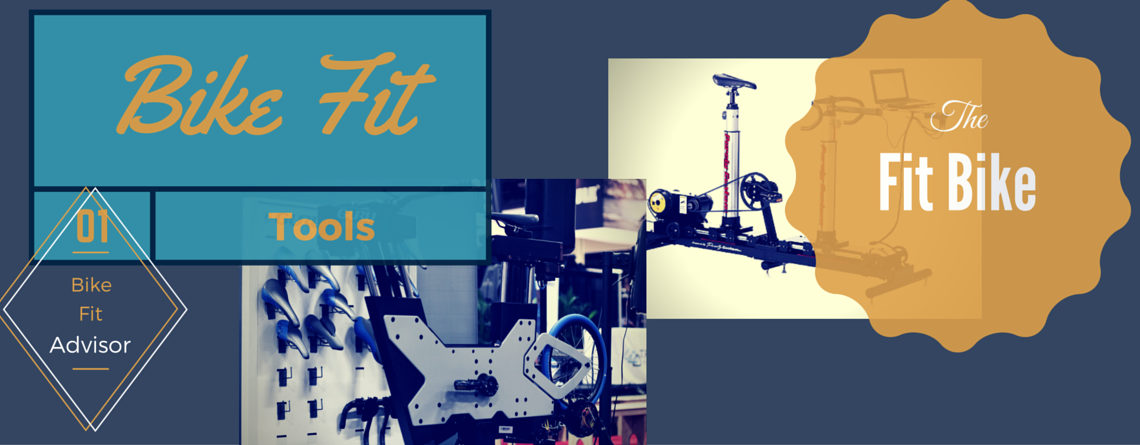Bike Fit Tools: the Fit Bike
In this series on bike fit tools I'll be going in depth about the different equipment available to bike fitters. I'll discuss how they're used, how much they cost, and the pros and cons of using them. Hopefully through these articles you'll be able to get a sense of what tools suit your needs, goals, budget and fit sensibility.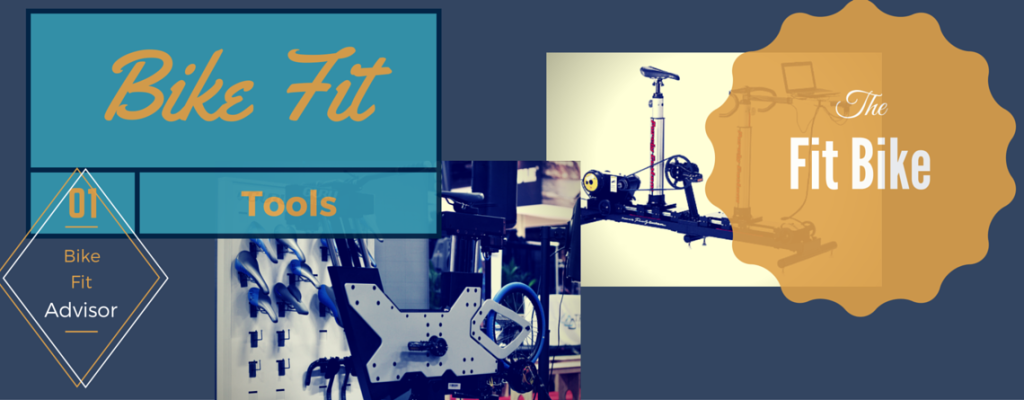 Today I'm going to go over the Fit Bike.A Fit Bike or adjustable size cycle is a stationary bicycle that has all of it's cardinal dimensions -- saddle height, seat, bar reach and height adjustable in some way. Some of the early version looked like an actual bike frame and the "tubes" of the frame could be adjusted to different lengths to mock up different seat and head angles, effective top tube and head tube lengths among others.The Serotta Size Cycle was on of these bikes. It did the job fairly well at the time but it was sometimes finicky in its adjustment -- adjusting bar height (head tube length) required multiple parts to be changed so that a horizontal orientation of the top tube was maintain.Newer versions of fit bikes simply rely on two vertical posts that hold the saddle and the handlebars respectively, and each post can telescope up and down to adjust bar and saddle height. These posts are also mounted on their own set of linear rails alowing for fore/aft movement of each post.
Today I'm going to go over the Fit Bike.A Fit Bike or adjustable size cycle is a stationary bicycle that has all of it's cardinal dimensions -- saddle height, seat, bar reach and height adjustable in some way. Some of the early version looked like an actual bike frame and the "tubes" of the frame could be adjusted to different lengths to mock up different seat and head angles, effective top tube and head tube lengths among others.The Serotta Size Cycle was on of these bikes. It did the job fairly well at the time but it was sometimes finicky in its adjustment -- adjusting bar height (head tube length) required multiple parts to be changed so that a horizontal orientation of the top tube was maintain.Newer versions of fit bikes simply rely on two vertical posts that hold the saddle and the handlebars respectively, and each post can telescope up and down to adjust bar and saddle height. These posts are also mounted on their own set of linear rails alowing for fore/aft movement of each post. 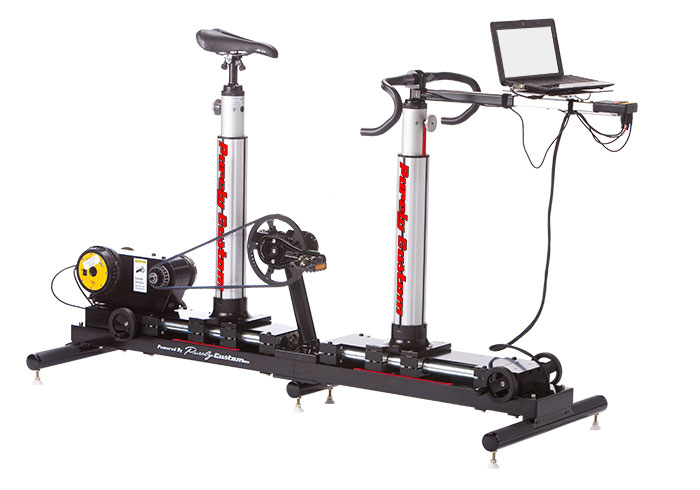 The handlebar post moving fore/aft will increase/decrease the reach to the bars. The saddle post moving fore/aft effectively changes the seat angle. Small hand wheels allow for adjustment up/down and fore/aft of both posts while the rider is pedaling which allows forThe Purely Custom fit bike (pictured above) adjusts in this way.Guru and Retul make fit bikes that follow this general principle although one of their posts is not vertical -- for the Guru it is the handlebar post:
The handlebar post moving fore/aft will increase/decrease the reach to the bars. The saddle post moving fore/aft effectively changes the seat angle. Small hand wheels allow for adjustment up/down and fore/aft of both posts while the rider is pedaling which allows forThe Purely Custom fit bike (pictured above) adjusts in this way.Guru and Retul make fit bikes that follow this general principle although one of their posts is not vertical -- for the Guru it is the handlebar post: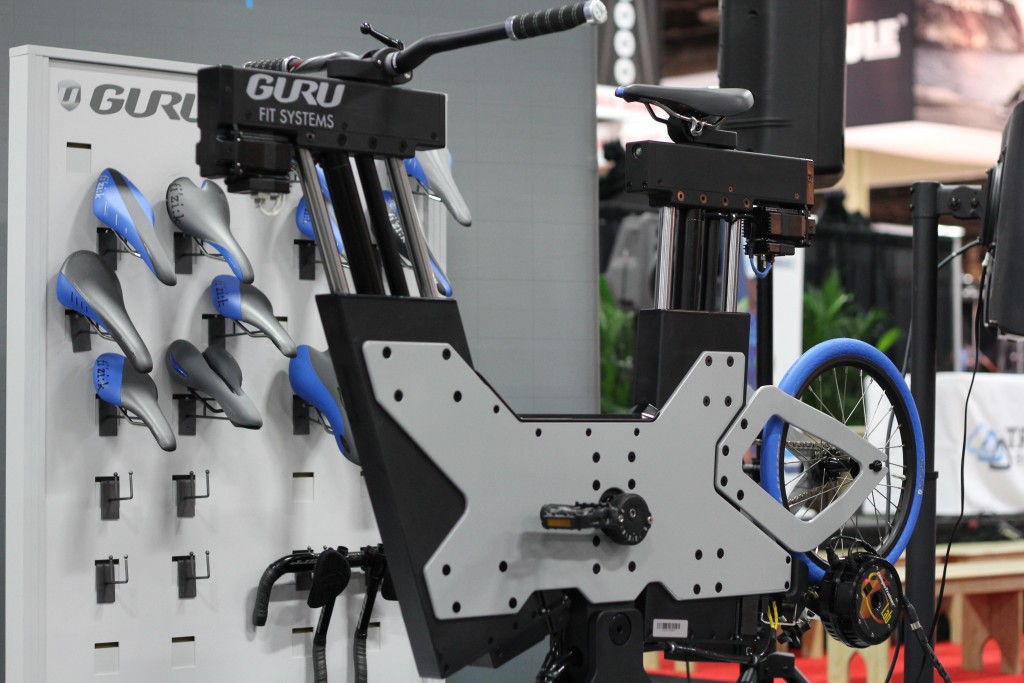 While the Retul fit bike's saddle post is at an angle:
While the Retul fit bike's saddle post is at an angle: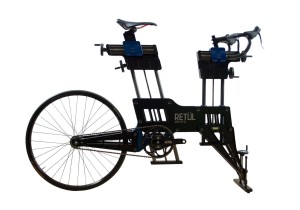 One important difference to note is that the Retul bike adjusts via hand wheels like the Purely Custom while the Guru uses motors, this raises the cost quite a bit which we'll get into in a little bit.
One important difference to note is that the Retul bike adjusts via hand wheels like the Purely Custom while the Guru uses motors, this raises the cost quite a bit which we'll get into in a little bit.
How do we get measurements off these fit bikes?
Since these bikes don't look like traditional double diamond bike frames we need some other way to get the measurements off them for seat angle, effective top tube, etc.Two "new" measurements of bike dimensions have made this much easier and more uniform. Stack and Reach have been used for many years but many cyclists are unfamiliar with them.The stack and reach of a frame or a bike can be measured to produce good apples to apples comparisons between bikes or fit setups. The stack of a frame is the vertical distance between the center of the bottom bracket and the center of the top of the head tube. The reach of the frame is then simply the horizontal distance between these two points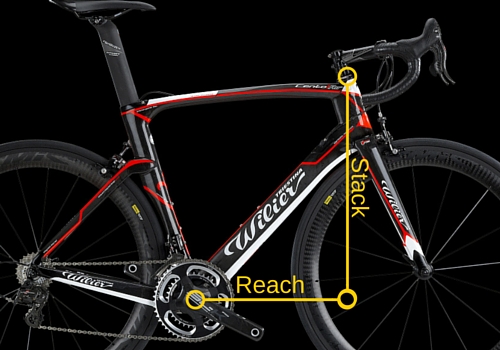 Each of these fit bike manufacturers has their own method of breaking down the coordinates into stack and reach by either electronic or analog means.
Each of these fit bike manufacturers has their own method of breaking down the coordinates into stack and reach by either electronic or analog means.
Bike Fit Equipment: How much do Fit Bikes cost?
Retul Muve SL $7900 ; but this generally assumes that you already have the Retul infrared motion capture system which will run you somewhere in the ballpark of $11,000 on its own.Purely Custom $9500 - $12,995 ; depending on the model and the bells and whistles you chooseGuru Fit System - let's just say it's going to run you somewhere in the $20,000-$35,000 range ; the Guru Fit System is tied to the parent companies servers and so continued access to the use of the bike depends on you keeping up with annual fees etc. I don't know if this is still the case, but in addition to the high cost, you never really owned the bike -- you were sort of leasing it from Guru.So none of these bikes are cheap, but let's take a look at their intended use:As in any other bike fitting scenario, these fit bikes are used for:
- completing a bike fit on a client's existing bike, or
- determining the fit for a new bike -- stock or custom
Existing Bike Fit
In this scenario, a client comes in with their own bike that they intend to keep -- they just want it to fit them better (and they want to fit it better). In order to make use of the fit bike, the fitter has two options to proceed:
- They can mock up the client's current fit coordinates on the fit bike (hopefully with the same saddle, handlebar shape and grips/shifter hoods) and using that as a starting point, make adjustments to the contact points (via adjustment of the handwheels or motors). Once a good fit has been determined, they then have to transfer the new fit coordinates to the existing bike.
- They can start somewhere close to the client's current position, but not try to replicate it exactly, and again make adjustments to the contact points until a good fit is determined (however they choose to do that).
Both of these methods is considered a "blue sky" bike fit -- meaning because the fit is done on the fit bike, which is infinitely adjustable, there are no restrictions on what changes can be made so that the absolute optimal position can be achieved for this client.This sounds great. "Blue sky" has such a nice ring to it, and I can appreciate the benefit of this approach. When done right, it can be very effective and very fast.But what does it mean to "do it right"? This is where it gets tricky...First, the position of the client's bike needs to be replicated exactly, down to the same saddle, bar shape and shifter-hood position. This can be tricky to do sometimes, but it's not impossible. Why this attention to detail? Because any differences in these contact points is going to change how the person sits on the fit bike and it's no longer "their" bike and we don't have an equal comparison. Different saddles can change where the pelvis rests, poorly placed shifter-hoods change the wrist position (which changes the elbow, shoulder, spine....).Second, the initial changes need to be done in small increments and slowly, because to the client, large changes done too quickly can throw off the rider's proprioceptive sense making it difficult for them to tell when the fit has gotten better rather than just getting different. The fitter doesn't always need to rely on the rider's subjective feedback but large changes done too fast tend to take it off the table.Unfortunately many fitters and bike shops rely on this. They use the fit bike to get the client off their existing bike with the intention
Pros
- Like all tech, they provide a "Wow" factor to clients.
- Using a fit bike like one of these allows the fitter to consider more fit positions more quickly. There is greater range of adjustability when using one.
Cons
- They're expensive
- They are quicker when executing the fit but they require more time to mock up into the client's starting fit position.
Verdict:
In my opinion, an expensive fit bike is a luxury, not a necessity. They can be very nice to have around in certain situations - especially when in the planning stages of building a new bike for a client - but they need to be used carefully.There is a lot of opportunity to turn a bike fit from how can we reasonably modify your current bike to fit you better into here is the absolute best no compromise position for you and it doesn't work with your current bike so you'll need either significant part swaps or a new bike altogether. We should always strive for the best fit possible for our clients, but this needs to be balanced with their expectations, goals, and budget. I have had clients come to me having had a blue sky fit on a fit bike where the fitter recommended major parts changes to their current bike totaling over $600 (in addition to the fitting fee). Skeptical, they came to me, and we made changes to their current bike, spent under $100 on parts and eliminated all their pain on the bike. Might the extra parts have improved the client's fit? Perhaps, but was it $500 better?Another problem rests in the large changes to a bike fit that fit bikes can often lead to. Yes, it can be a benefit to have all the adjustability from the fit bike, but the ability to change a lot often leads to a lot of changes. Again, why is this bad, if the changes improve things?Because of neuromuscular compensation. Specifically the schedule on which it takes place.Neuromuscular compensation is the idea that when we change the parameters of someone's bike fit, we do see some of the changes right away. Often, we see about 30%-50% of potential changes on day one. Over the course of the next few weeks is when the remaining 50%-70% of changes occurs. We don't reach a static position right away when changing things around because the body has to adapt to the new position. Muscles and tendons have to get used to the new lengths that we're asking them to work at and more globally, the central nervous system essntially has to create a new motor plan on how to coordinate the pedal stroke.The same thing happens when correcting someone's technique for squatting. Just because we cue this correction and the client's motion has improved does not mean that they have immediately assimilated the new form fully -- it often takes weeks groove this pathway into permanence.So if we make large corrections to someone's bike fit, more than we need to see this inital 30%-50% change, we run the risk of having them over-correct as they accommodate to this new position in the next few weeks. "Over-correction" really means creating a problem somewhere else.I recently had a client come see me for a bike sizing appointment. She wasn't sure what make and model of bike she wanted, but she was doing it right and was getting fit and sized first. She had been to another local bike shop first and they had gotten her on a fit bike. Once they completed her fitting, however, they would only point her to the bikes on the floor of their shop that matched the fit prescription they recommended. She tried repeatedly to get the measurements so she could do more research before jumping into the bike purchase. She received no explanation or education, it was merely a cheap ploy to pressure her into buying from them. (And, yes, she had already payed separately for the fitting as a service on it's own)This brings me to my final point. Each of these fit bikes mentioned today are offered with some version of a "bike finder" software. Essentially, once fit coordinates are determined they get run through this separate software program which points to particular bike models and sizes that wil fit the client. I'll discuss these programs in another article to come as another bike fit tool. This software will help you find a bike that matches your fit prescription, but they are almost exclusively used to point toward bikes that are carried by the shop doing the fitting. I get it....shops are in the business to make money. But if a client is coming in to pay for a service that is supposed to help them find the best bike for them and they get the best fitting bike that happens to be in that shop, those are two very different things with competing purposes.So the fit bike as a tool can be a good one. It has a pretty steep price tag in most cases. It's not a necessary tool though in order to even have an advanced and thriving bike fit practice.

